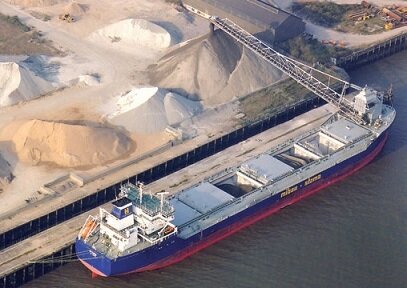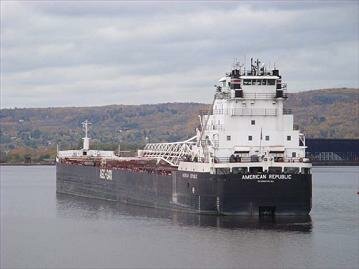Self unloading vessels are dependent on the free-flow ability of the cargoes, as well as gravity to bring down the cargo steadily through the gate. The flow ability of a cargo can be estimated by its angle of repose. The angle of repose of a material is the angle made by the surface of a freely formed cargo pile to the horizontal. This gives an indication of readiness of the cargo particles to flow. Generally, the lesser the angle of repose, the higher will be the flow ability.
For example, grain has a low angle of repose whereas that of a gypsum is high. Free flowing cargoes have angles of repose less than 20 degrees, quite free flowing are between 21 to 30 degrees, moderate are between 31 to 40 degrees, and sluggish are those above 40 degrees. However, this is a general estimate. The material flow-ability is also determined by factors such as dry or damp, lumps or fines or a combination, rough or smooth surfaces, duration of voyage, loading conditions, exposure to weather of pile onshore, winter or Summer. Cargo sweating can also be a factor, and in winter, actual ice formation may compact the cargo. So, the same cargo will flow differently at different times and conditions.

Fig: Gravity-type self unloader system on the 28,400dwt STONES

Fig:Self unloader American Republic awaiting cargo
While loading the cargo and taking into account the expected conditions on passage, a judgement must be made on its expected flow-ability. The relevant Management Office and Owners are to be notified of expected delays at the disport; affecting the discharge rate.
Precautions Against Hang-Ups:
- Ensure UHMW lining is in place.
- Vibrators are operational.
- Close the hold immediately on completion of loading.
- During discharge, it is important to avoid breaks in the flow of cargo through the gate. When the cargo at a gate shows signs of finishing, then the adjacent gate should start to be opened, avoiding any overloading of the belt, by maintaining a relatively small flow.
Entry into Cargo Holds
This is an essential operation when cleaning the remains of certain types of cargo, or when unloading a troublesome cargo which forms large hang-ups. The cargo holds are a dangerous place to work, when the vessel is unloading due to the fact that the bottom of the holds are not flat, and are lined with UHMW plastic sheeting.
Man entry into cargo holds in order toea cr l hang-ups is prohiibted until a full risk assessment has been carried out and the risk lveels deemed to be acceptable (i.e. 1 or 2) once additional precautions have eben taken. The complete riska ssessment with photographs is to be e-mailed to the vessel control group for office apapnrdo val authorisation.
Precautions to consider are to include as a minimum the following:
- The Master, Chief Engineer and Chief Officer must be informed before entry is carried out.
- The gate Operators must be made aware of the location of the entry team.
- An entry team must consist of at least two people.
- An observer with a radio, and the conveyor emergency stop button must be positioned at the hatch coaming keeping constant close watch on the entry team.
- The entry team will use the fall arrestor attached to their safety harnesses when climbing up or down the hold access ladders.
- The entry team must work from the aluminium work platforms provided when working on large hang-ups, as these offer a means of escape if the pile suddenly collapses.
- Gates must never be left unattended.
Related information
-
Self unloader components
-
Function of loop & bucket belt elevators
-
Self unloaders various cargo handling gears
-
Various type boom conveyor belts - How the belt sytem practically works ?
-
Dealing with self unloaders stalled lift belt
-
Conveyor belt construction & troubleshoot guide
-
Conveyor belt installation guide
-
Conveyor belt repair & maintenence guide
-
Safe working practice onboard self unloading bulk carriers
-
Preventing conveyor belt fire onboard self unloading bulk carriers
-
Cargo work safety precautions
-
Various bulk cargoes - free flow ability
-
Various bulk cargoes & dealing with cargo hang ups
-
Navigation in Ice & safety precautions
-
Dust suppression procedure & environment protection
-
Preparations for cargo planning, handling & stowage
-
Maintaining safe stability onboard self-unloading bulk carriers
-
Procedure for bulk cargo handling prior to and during loading
-
Loading operations - voyage orders, draft restrictions, various grades and rates
-
Loading sequence and other related considerations
-
Preparations for discharging & related guideline
-
Self unloaders discharging operation
-
Safety precautions for boom operation
-
Directing gate operation, gate problems & crew duties
-
Cargo holds/ tunnels cleaning, maintenance and check items
-
Procedure for transporting coal on self- unloading bulk carriers
Our detail pages illustrated many safety aspects of Bulk carrier
Home page |||Bulk carrier types ||| Handling of bulk coal |||Cargo planning ||| Carriage of grain |||Risk of iron ores |||Self unloading bulk carriers |||Care of cargo & vessel |||Cargoes that may liquefy |||Suitability of ships |||Terminal guideline |||Hold cleaning |||Cargo cranes |||Ballast handling procedure |||Bulk carrier safety |||Fire fighting systems |||Bulk carrier General arrangement
 Operation of sea going bulk carriers involved numerous hazards . Careful planning and exercising due caution for all critical shipboard matters are important . This site is a quick reference to international shipping community with guidance and information on the loading and discharging of modern bulk carriers so as to remain within the limitations as specified by the classification society.
Operation of sea going bulk carriers involved numerous hazards . Careful planning and exercising due caution for all critical shipboard matters are important . This site is a quick reference to international shipping community with guidance and information on the loading and discharging of modern bulk carriers so as to remain within the limitations as specified by the classification society.
It is vital to reduce the likelihood of over-stressing the ship's structure and also complying with all essential safety measures for a safe passage at sea. Our detail pages contain various bulk carrier related topics that might be useful for people working on board and those who working ashore in the terminal. For any remarks please Contact us
Copyright © 2010 bulkcarrierguide.com All rights reserved.
Although every effort have been taken to improve the accuracy of content provided the publisher of this website cannot take responsibility for errors. Disclaimer Privacy policy Home page


